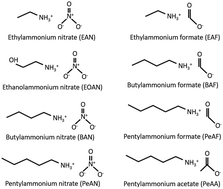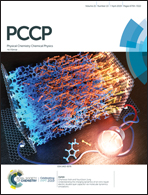High throughput approach to investigating ternary solvents of aqueous non-stoichiometric protic ionic liquids†
Abstract
The use of ionic liquids (ILs) is limited for many applications due to their cost and/or viscosity. An efficient solution is to make mixtures of ILs with molecular solvents. However, it is well known that there are a large number of possible cation and anion combinations resulting in ILs, and this becomes a vast number when these are then combined with a molecular solvent. Therefore, we need structure–property relationships to design new IL–molecular solvent systems. In this work we have applied high throughput methods to investigate IL containing solutions to provide systematic data of a broad compositional space. We have principally focused on the surface tension, apparent pH and liquid nanostructure to identify potential self-assembly and protein stabilizing ability of solvent systems. Non-stoichiometric and aqueous IL–solvents were prepared in a high-throughput manner based on a deliberate experimental design approach such that 26 samples were prepared for each cation–anion–water combination. A selection of 8 protic ionic liquids (PILs) were used as starting materials, comprising ethanol-, ethyl-, butyl-, and pentylammonium cations combined with formate, acetate and nitrate anions. This resulted in a total of 208 different solvent systems. The measured solvent properties showed different trends in base-rich and acid-rich solvent combinations. Surface tensions of base-rich samples exhibited a relatively linear relationship with increasing excess amine, while acid-rich samples were more dominantly affected by the change in water content. Liquid nanostructure of acid-rich samples was retained upon water dilution, whereas a significant SAXS peak shift towards lower scattering angles was observed in the presence of excess amines, indicating larger nanosized aggregates were forming. The design of experiment approach used here is considered to be applicable to any multi-component solvent compositional space due to its suitability in using small data sets to cover large compositional spaces, and hence can be employed to decrease the time and sample quantities required.



 Please wait while we load your content...
Please wait while we load your content...